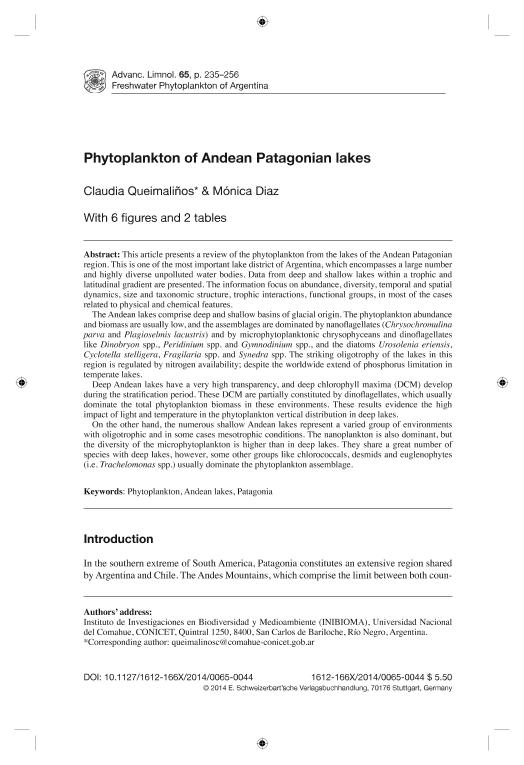Mostrar el registro sencillo del ítem
dc.contributor.author
Queimaliños, Claudia Patricia

dc.contributor.author
Diaz, Monica Mabel

dc.date.available
2017-01-19T19:21:18Z
dc.date.issued
2014-07
dc.identifier.citation
Queimaliños, Claudia Patricia; Diaz, Monica Mabel; Phytoplankton of the Andean Lakes; Schweizerbart; Advances in Limnology, Archiv Fur Hydrobiologie, Special Issues; 65; 7-2014; 235-256
dc.identifier.issn
1612-166X
dc.identifier.uri
http://hdl.handle.net/11336/11647
dc.description.abstract
This chapter presents a review of the phytoplankton from the lakes of the Andean Patagonian region. This is one of the most important lake district of Argentina, which encompasses a large number and highly diverse unpolluted water bodies. Data from deep and shallow lakes within a trophic and latitudinal gradient are presented. The information focus on abundance, diversity, temporal and spatial dynamics, size and taxonomic structure, trophic interactions, functional groups, in most of the cases related to physical and chemical features. The Andean lakes comprise deep and shallow basins of glacial origin. The phytoplankton abundance and biomass are usually low, and the assemblages are dominated by nanoflagellates (Chrysochromulina parva and Plagioselmis lacustris) and by microphytoplanktonic chrysophyceans and dinoflagellates like Dinobryon spp., Peridinium spp. and Gymnodinium spp., and the diatoms Urosolenia eriensis, Cyclotella stelligera, Fragilaria spp. and Synedra spp. The striking oligotrophy of the lakes in this region is regulated by nitrogen availability; despite the worldwide extend of phosphorus limitation in temperate lakes. Deep Andean lakes have a very high transparency, and deep chlorophyll maxima (DCM) develop during the stratification period. These DCM are partially constituted by dinoflagellates, which usually dominate the total phytoplankton biomass in these environments. These results evidence the high impact of light and temperature in the phytoplankton vertical distribution in deep lakes. On the other hand, the numerous shallow Andean lakes represent a varied group of environments with oligotrophic and in some cases mesotrophic conditions. The nanoplankton is also dominant, but the diversity of the microphytoplankton is higher than in deep lakes. They share a great number of species with deep lakes, however, some other groups like chlorococcals, desmids and euglenophytes (i.e. Trachelomonas spp.) usually dominate the phytoplankton assemblage.
dc.format
application/pdf
dc.language.iso
eng
dc.publisher
Schweizerbart
dc.rights
info:eu-repo/semantics/openAccess
dc.rights.uri
https://creativecommons.org/licenses/by-nc-sa/2.5/ar/
dc.subject
Phytoplankton
dc.subject
Andean Lakes
dc.subject
Patagonia
dc.subject.classification
Biología Marina, Limnología

dc.subject.classification
Ciencias Biológicas

dc.subject.classification
CIENCIAS NATURALES Y EXACTAS

dc.title
Phytoplankton of the Andean Lakes
dc.type
info:eu-repo/semantics/article
dc.type
info:ar-repo/semantics/artículo
dc.type
info:eu-repo/semantics/publishedVersion
dc.date.updated
2016-12-12T14:20:22Z
dc.journal.volume
65
dc.journal.pagination
235-256
dc.journal.pais
Alemania

dc.journal.ciudad
Stuttgart
dc.description.fil
Fil: Queimaliños, Claudia Patricia. Consejo Nacional de Investigaciones Científicas y Técnicas. Centro Científico Tecnológico Patagonia Norte. Instituto de Investigación En Biodiversidad y Medioambiente; Argentina. Universidad Nacional del Comahue; Argentina
dc.description.fil
Fil: Diaz, Monica Mabel. Consejo Nacional de Investigaciones Científicas y Técnicas. Centro Científico Tecnológico Patagonia Norte. Instituto de Investigación En Biodiversidad y Medioambiente; Argentina. Universidad Nacional del Comahue; Argentina
dc.journal.title
Advances in Limnology, Archiv Fur Hydrobiologie, Special Issues
dc.relation.alternativeid
info:eu-repo/semantics/altIdentifier/url/https://www.schweizerbart.de/papers/adv_limnology/detail/65/84045/Phytoplankton_of_Andean_Patagonian_lakes
dc.relation.alternativeid
info:eu-repo/semantics/altIdentifier/doi/http://dx.doi.org/10.1127/1612-166X/2014/0065-0044
Archivos asociados
